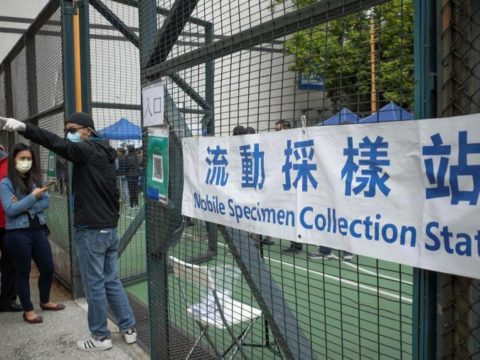
BEIRUT, July 31 (Reuters) – Part of the grain silos at Beirut Port collapsed on Sunday just days before the second anniversary of the massive explosion that damaged them, sending a cloud of dust over the capital and reviving traumatic memories of the blast that killed more than 215 people.
There were no immediate reports of injuries.
Lebanese officials warned last week that part of the silos – a towering reminder of the catastrophic Aug. 4, 2020 explosion – could collapse after the northern portion began tilting at an accelerated rate.
Register now for FREE unlimited access to Reuters.com
“It was the same feeling as when the blast happened, we remembered the explosion,” said Tarek Hussein, a resident of nearby Karantina area, who was out buying groceries with his son when the collapse happened. “A few big pieces fell and my son got scared when he saw it,” he said.
A fire had been smoldering in the silos for several weeks which officials said was the result of summer heat igniting fermenting grains that have been left rotting inside since the explosion.
The 2020 blast was caused by ammonium nitrate unsafely stored at the port since 2013. It is widely seen by Lebanese as a symbol of corruption and bad governance by a ruling elite that has also steered the country into a devastating financial collapse.
One of the most powerful non-nuclear blasts on record, the explosion wounded some 6,000 people and shattered swathes of Beirut, leaving tens of thousands of people homeless.
Ali Hamie, the minister of transport and public works in the caretaker government, told Reuters he feared more parts of the silos could collapse imminently.
Environment Minister Nasser Yassin said that while the authorities did not know if other parts of the silos would fall, the southern part was more stable.
The fire at the silos, glowing orange at night inside a port that still resembles a disaster zone, had put many Beirut residents on edge for weeks.
‘REMOVING TRACES’ OF AUG. 4
There has been controversy over what do to with the damaged silos.
The government took a decision in April to destroy them, angering victims’ families who wanted them left to preserve the memory of the blast. Parliament last week failed to adopt a law that would have protected them from demolition.
Citizens’ hopes that there will be accountability for the 2020 blast have dimmed as the investigating judge has faced high-level political resistance, including legal complaints lodged by senior officials he has sought to interrogate.
Prime Minister-designate Najib Mikati has said he rejects any interference in the probe and wants it to run its course.
However, reflecting mistrust of authorities, many people have said they believed the fire was started intentionally or deliberately not been contained.
Divina Abojaoude, an engineer and member of a committee representing the families of victims, residents and experts, said the silos did not have to fall.
“They were tilting gradually and needed support, and our whole goal was to get them supported,” she told Reuters.
“The fire was natural and sped things up. If the government wanted to, they could have contained the fire and reduced it, but we have suspicions they wanted the silos to collapse.”
Reuters could not immediately reach government officials to respond to the accusation that the fire could have been contained.
Earlier this month, the economy minister cited difficulties in extinguishing the fire, including the risk of the silos being knocked over or the blaze spreading as a result of air pressure generated by army helicopters.
Fadi Hussein, a Karantina resident, said he believed the collapse was intentional to remove “any trace of Aug. 4”.
“We are not worried for ourselves, but for our children, from the pollution,” resulting from the silos’ collapse, he said, noting that power cuts in the country meant he was unable to even turn on a fan at home to reduce the impact of the dust.
Register now for FREE unlimited access to Reuters.com
Writing by Nayera Abdallah and Tom Perry
Editing by Hugh Lawson, Nick Macfie and Frances Kerry
Our Standards: The Thomson Reuters Trust Principles.














